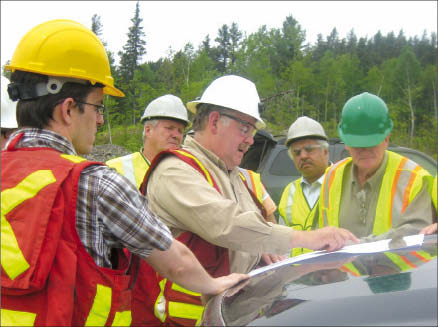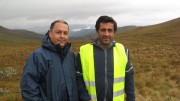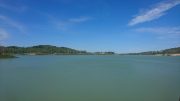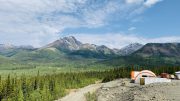It’s been a slow ride for Wallbridge Mining (WM-T), but one that has been picking up. With one spin out, another in the making and a project near production, the explorer is ready to change gears.
“We’re trying to take things in the money direction,” Warren Holmes, Wallbridge’s chairman, says at a dinner here in early June. And he’s confident the train for the Sudbury basin-based explorer is heading towards mining.
Wallbridge is looking to put its Broken Hammer copper-platinum-palladium-gold deposit into production by 2012.
In late June, it finished shipping a 30,500-tonne bulk sample from its most advanced project to Xstrata‘s (XTA-L) Strathcona mill in town for processing. The metallurgical recoveries, along with results from a recently completed drill program, will be used to enhance the resource estimate and complete a feasibility study.
The project’s current resource is on the northern rim of the Sudbury igneous complex, and forms a surface zone of vein- and stockwork-hosted copper and platinum group elements (PGE). Broken Hammer has an inferred resource of 251,000 tonnes at 3.80 grams per tonne of total precious metals, (1.56 grams palladium, 1.62 grams platinum and 0.61 gram gold per tonne), 1% copper and 0.10% nickel.
The resource, prepared by Roscoe Postle Associates in 2005, used a cut-off value of $40 per tonne, and the then-long-term metal prices of US$800 per oz. platinum, US$180 per oz. palladium, US$400 per oz. gold, US$1.40 per lb. copper and US$5 per lb. nickel.
The new resource estimate and feasibility study will use the current long-term metal prices. Wallbridge plans to launch the study once the bulk sample results are out later this summer.
The junior discovered the Broken Hammer zone as a result of an ongoing grassroots exploration program in 2004, Wallbridge’s president and CEO Alar Soever says.
“The discovery outcrop had been mapped previously by other guys who called it granite. Our guys were trained to break a lot more rock and look at it,” Soever says.
“They saw a few grains of chalcopyrite in the first outcrop. And then, they started peeling back moss and hammering away on the other outcrops in the area. They broke a hammer . . . Once they started to see the better mineralization, they got a little over-excited and started banging away with their hammers, and broke a couple. So, they called it the Broken Hammer deposit,” he says.
The Broken Hammer property was previously part of Falconbridge’s Wisner property, which Wallbridge joint-ventured from the major.
The company holds 98.5% of the Broken Hammer property, while Xstrata Nickel holds a 1.5% net smelter return interest.
Spin outs
In 2005, to finance its Minnesota properties, Wallbridge spun out those assets into a new company called Duluth Metals (DM-T), which began trading on the Toronto Stock Exchange in 2006. As part of the transaction, Wallbridge shareholders received one Duluth share for every four Wallbridge shares held. The company also got 10 million Duluth shares.
To date, Wallbridge owns 8.9%, or 11.1 million Duluth shares. At the end of March 2011, these shares were worth $24.1 million, or $2.17 per share. The company says the Duluth shares are an important part of the underlying value in Wallbridge, because they provide financial stability.
From last September to January 2011, the company sold 1.1 million Duluth shares to raise a total of $3.4 million. The money went towards bulk sampling the Broken Hammer deposit, and advancing the company’s other Sudbury projects.
Wallbridge had deferred the bulk sampling during the financial crisis of 2008 and 2009 because of the collapse of metal prices, Soever says, adding that the sample, which was initiated in late 2010, should now make the company a profit. It should also confirm the grades of the resource, which contains coarse grains of platinum.
The junior can increase its current interest in Duluth from 8.9% to 15.67%, by exercising its participation right in certain future equity issuances.
Duluth Metals’ flagship asset is the Nokomis copper-nickel-PGE project, which is 40%-held by partner Antofagasta (ANTO-L).
The project sits in the Duluth complex mining camp in northeastern Minnesota, and hosts a National Instrument 43-101 compliant resource of 550 million indicated tonnes of 0.639% copper, 0.200% nickel and 0.66 gram per tonne platinum, palladium and gold (TPM). It has another 274 million inferred tonnes at 0.632% copper, 0.207% nickel and 0.68 gram per tonne TPM.
Over the next three years, Antofagasta will spend US$130 million to advance the project towards a feasibility study.
In March, Duluth Metals acquired Franconia Minerals to add several nearby resources to Nokomis, with three NI 43-101 compliant resources at the Maturi, Birch Lake and Spruce Road deposits. As part of the arrangement, Antofagasta gave Duluth $30 million to keep its current equity interest, which included a $20-million placement of 7.6 million Duluth shares at $2.63.
Duluth wholly owns interests in 310-sq.-km of the Duluth complex.
With the success of Duluth, Wallbridge is in the midst of listing its second spin-out company – Miocene Metals – on the TSX Venture Exchange.
Wallbridge spun out seven of its porphyry copper-gold-molybdenum properties in southwestern B.C. into the new company last April. The properties cover the Miocene age intrusions of the Cascade Magmatic Arc, an underexplored belt with porphyry-style mineralization.
Soever says the Miocene spin out is a way to share exploration risks without diluting Wallbridge and its shareholders from the Duluth asset. “Why would you dilute yourself out of that asset to go and do grassroots explorations, when you can go do that in a new vehicle, of which we are keeping a piece of? If it does well, we do well, our shareholders do well. There’s no risk to the mother ship.”
Wallbridge received 20 million Miocene shares for vending in the properties, and bought another 2 million shares in a recent private placement. It gave about 700,000 of those shares to Paget Minerals (PGS-V) for the Salal claims. As of the end of March, Wallbridge held 21.3 million Miocene shares, or 66% of the company. It also has an 11.63% carried interest in the seven B.C. properties.
Last May, Wallbridge shareholders received one special warrant of Miocene for every six Wallbridge shares held. Once Miocene wraps up its initial public offering, Wallbridge shareholders could convert their special warrants into Miocene shares.
Miocene started exploring the properties as a private company in 2010. It plans to launch an aggressive drill program in mid-July. The two-phase, $4-million program will be funded using flow-through funds raised in 2010, and the net proceeds of the company’s IPO, which is underway.
This year, Miocene will be testing targets along a 15-km trend of molybdenite occurrences on
the Salal property, and drilling its MacKenzie and Roger Creek properties.
Soever lists Broken Hammer, Duluth and Miocene Metals as the three value centres for Wallbridge shareholders.
Mining in Sudbury
“Sudbury is always known for its nickel,” says the company’s manager of joint ventures, Joshua Bailey, noting the Sudbury basin has seen more than 125 years of mining.
“But there are significant [amounts of] precious metals in the camp, and, in particular, in these footwall copper and platinum group type of deposits that we are looking for.”
The company is hunting for footwall deposits and offset dykes rich in platinum group metals because of their higher value per tonne.
Traditionally the majors in the area, Inco and Falconbridge, focused on deposits that were rich in nickel along the contact of the Sudbury igneous complex.
But a lot has changed since the ’70s as to how f
ar one should look from the contact, Soever says, explaining that the majors would drill to the contact and stop once they hit a nickel-copper zone.
“But with the prices of metals on the rise, the platinum group metals in the footwalls have become more attractive,” though they are smaller and harder to find.
The footwall, offset dyke and nickel-rich contact deposits are the three main types of ore found in Sudbury.
It’s widely believed that the ore in Sudbury formed as a result of a 1.85-billion-year-old meteorite, Wallbridge notes in its 2010 annual report. Upon impact, the meteorite smashed and melted the local metal-rich rocks to create a 250-km-diameter crater with a 3-km-thick melt sheet of molten rock. Upon cooling, the heavier base and precious metals sunk to the bottom of the melt sheet and into the fractures of the underlying rocks, which created offset and footwall deposits. The melt sheet then solidified to form the Sudbury igneous complex.
The company is exploring the footwall deposits at Broken Hammer and the joint-ventured Frost Lake project, among its other properties in the area.
In total, the explorer has 42 properties in Sudbury spanning 730 sq. km, making it the third-largest land holder in the area after Vale (VALE-n) and Xstrata. But only 14 of those projects are active.
While the junior has many projects to choose from, Bailey says, it has four key stories in Sudbury. He lists them as: Broken Hammer, the joint-venture Parkin Offset project, the fairly grassroots East Range area, and the developing large North Range.
The junior is spending $5.9 million to drill 10,000 metres this year on its areas of interest.
About $2.4 million of that amount was committed by its various JV partners.
Soever says the company has several partners, in order to spread the risks and costs of exploring early-stage projects.
“When you have a grassroots property, it’s better to share the risks on the one property. When you find something, sure, you are giving away some of the upside. If you don’t find anything, you spend other people’s money and avoid diluting the company as a whole.”
Wallbridge attracted the attention of Impala Platinum with its Parkin Offset property in 2008. The joint-venture covers 9.4 km of the Parkin Offset dyke and includes the past-producing Milnet mine. The mine saw a historic production of more than 157,000 tons grading 2.25 grams platinum, 2.98 grams palladium, 0.33 gram gold, 1.49% copper and 1.54% nickel.
The partners say they are reviewing last year’s drill results before drilling this year at the Milnet 1500 zone, which was discovered in 2009 and lies beneath the Milnet mine.
Impala recently paid $5 million to earn a 50% stake in the Parkin Offset property, which it can boost to 65% by funding a feasibility study.
In the East Range, where exploration is centred on copper-PGE footwall deposits, the company has its Skynner Lake and Frost Lake properties. This year, the company plans to drill 2,500 metres at Frost Lake, with Xstrata. The companies will test several targets near the Amy Lake PGE zone at Frost Lake, where Wallbridge is the project’s operator and has a 58% interest.
The Skynner Lake property is part of the Sudbury Camp Joint Venture (SCJV) with Lonmin (LMI-L). The JV includes seven Sudbury properties, where Lonmin can earn 50% in any of the properties by outlining an indicated resource, and another 15% by funding a feasibility study.
Lonmin has contributed $1 million this year to the $1.25-million SCJV exploration budget to explore the properties.
In the North Range, Wallbridge has 12 packages which include JV with Champion Bear Resources (CBA-V), Pele Mountain Resources (GEM-V) and CaNickel Mining (CML-T), formerly Crowflight Minerals.
The properties in the North Range are situated north of the Onaping-Levack area, which hosts many producing and past-producing mines, as well as the Strathcona mill.
But the focus in that area is the Hess Offset dyke, which the company traced for more than 21 km across its own properties and its joint-ventures with Champion Bear and Pele Mountain. The company says outcrop exposure is generally poor at less than 1%. Surface mineralization has been located in various places along its length.
While Wallbridge has a lot of drilling planned this year, chairman Holmes says completing the Miocene spinoff is “extremely important,” even as the company continues to develop Broken Hammer and its other Sudbury projects.
“Our focus is this pipeline of projects. We will continue to exploit it, and see how much we can do,” he says. “The ride ahead should be an exciting one.”
Wallbridge’s shares recently closed at 22.5¢, within a 52-trading range of 14.5¢-29.5¢.






Be the first to comment on "Wallbridge eyes producer status"